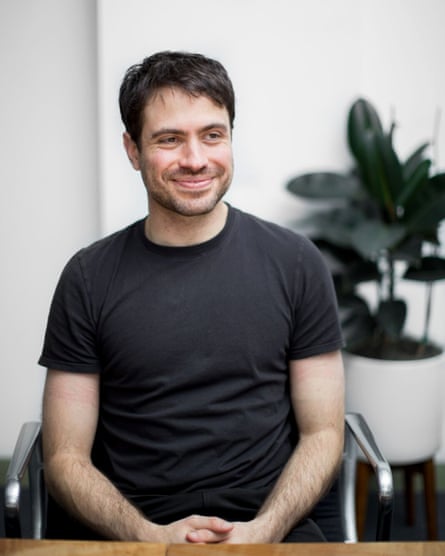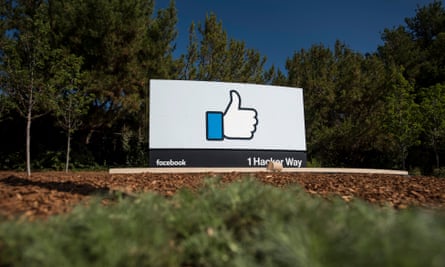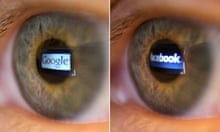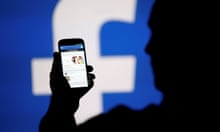Justin Rosenstein had tweaked his laptop’s operating system to block Reddit, banned himself from Snapchat, which he compares to heroin, and imposed limits on his use of Facebook. But even that wasn’t enough. In August, the 34-year-old tech executive took a more radical step to restrict his use of social media and other addictive technologies.
Rosenstein purchased a new iPhone and instructed his assistant to set up a parental-control feature to prevent him from downloading any apps.
He was particularly aware of the allure of Facebook “likes”, which he describes as “bright dings of pseudo-pleasure” that can be as hollow as they are seductive. And Rosenstein should know: he was the Facebook engineer who created the “like” button in the first place.
A decade after he stayed up all night coding a prototype of what was then called an “awesome” button, Rosenstein belongs to a small but growing band of Silicon Valley heretics who complain about the rise of the so-called “attention economy”: an internet shaped around the demands of an advertising economy.
These refuseniks are rarely founders or chief executives, who have little incentive to deviate from the mantra that their companies are making the world a better place. Instead, they tend to have worked a rung or two down the corporate ladder: designers, engineers and product managers who, like Rosenstein, several years ago put in place the building blocks of a digital world from which they are now trying to disentangle themselves. “It is very common,” Rosenstein says, “for humans to develop things with the best of intentions and for them to have unintended, negative consequences.”
Rosenstein, who also helped create Gchat during a stint at Google, and now leads a San Francisco-based company that improves office productivity, appears most concerned about the psychological effects on people who, research shows, touch, swipe or tap their phone 2,617 times a day.
There is growing concern that as well as addicting users, technology is contributing toward so-called “continuous partial attention”, severely limiting people’s ability to focus, and possibly lowering IQ. One recent study showed that the mere presence of smartphones damages cognitive capacity – even when the device is turned off. “Everyone is distracted,” Rosenstein says. “All of the time.”
But those concerns are trivial compared with the devastating impact upon the political system that some of Rosenstein’s peers believe can be attributed to the rise of social media and the attention-based market that drives it.
Drawing a straight line between addiction to social media and political earthquakes like Brexit and the rise of Donald Trump, they contend that digital forces have completely upended the political system and, left unchecked, could even render democracy as we know it obsolete.
In 2007, Rosenstein was one of a small group of Facebook employees who decided to create a path of least resistance – a single click – to “send little bits of positivity” across the platform. Facebook’s “like” feature was, Rosenstein says, “wildly” successful: engagement soared as people enjoyed the short-term boost they got from giving or receiving social affirmation, while Facebook harvested valuable data about the preferences of users that could be sold to advertisers. The idea was soon copied by Twitter, with its heart-shaped “likes” (previously star-shaped “favourites”), Instagram, and countless other apps and websites.
It was Rosenstein’s colleague, Leah Pearlman, then a product manager at Facebook and on the team that created the Facebook “like”, who announced the feature in a 2009 blogpost. Now 35 and an illustrator, Pearlman confirmed via email that she, too, has grown disaffected with Facebook “likes” and other addictive feedback loops. She has installed a web browser plug-in to eradicate her Facebook news feed, and hired a social media manager to monitor her Facebook page so that she doesn’t have to.

“One reason I think it is particularly important for us to talk about this now is that we may be the last generation that can remember life before,” Rosenstein says. It may or may not be relevant that Rosenstein, Pearlman and most of the tech insiders questioning today’s attention economy are in their 30s, members of the last generation that can remember a world in which telephones were plugged into walls.
It is revealing that many of these younger technologists are weaning themselves off their own products, sending their children to elite Silicon Valley schools where iPhones, iPads and even laptops are banned. They appear to be abiding by a Biggie Smalls lyric from their own youth about the perils of dealing crack cocaine: never get high on your own supply.
One morning in April this year, designers, programmers and tech entrepreneurs from across the world gathered at a conference centre on the shore of the San Francisco Bay. They had each paid up to $1,700 to learn how to manipulate people into habitual use of their products, on a course curated by conference organiser Nir Eyal.
Eyal, 39, the author of Hooked: How to Build Habit-Forming Products, has spent several years consulting for the tech industry, teaching techniques he developed by closely studying how the Silicon Valley giants operate.
“The technologies we use have turned into compulsions, if not full-fledged addictions,” Eyal writes. “It’s the impulse to check a message notification. It’s the pull to visit YouTube, Facebook, or Twitter for just a few minutes, only to find yourself still tapping and scrolling an hour later.” None of this is an accident, he writes. It is all “just as their designers intended”.
He explains the subtle psychological tricks that can be used to make people develop habits, such as varying the rewards people receive to create “a craving”, or exploiting negative emotions that can act as “triggers”. “Feelings of boredom, loneliness, frustration, confusion and indecisiveness often instigate a slight pain or irritation and prompt an almost instantaneous and often mindless action to quell the negative sensation,” Eyal writes.
Attendees of the 2017 Habit Summit might have been surprised when Eyal walked on stage to announce that this year’s keynote speech was about “something a little different”. He wanted to address the growing concern that technological manipulation was somehow harmful or immoral. He told his audience that they should be careful not to abuse persuasive design, and wary of crossing a line into coercion.
But he was defensive of the techniques he teaches, and dismissive of those who compare tech addiction to drugs. “We’re not freebasing Facebook and injecting Instagram here,” he said. He flashed up a slide of a shelf filled with sugary baked goods. “Just as we shouldn’t blame the baker for making such delicious treats, we can’t blame tech makers for making their products so good we want to use them,” he said. “Of course that’s what tech companies will do. And frankly: do we want it any other way?”
Without irony, Eyal finished his talk with some personal tips for resisting the lure of technology. He told his audience he uses a Chrome extension, called DF YouTube, “which scrubs out a lot of those external triggers” he writes about in his book, and recommended an app called Pocket Points that “rewards you for staying off your phone when you need to focus”.
Finally, Eyal confided the lengths he goes to protect his own family. He has installed in his house an outlet timer connected to a router that cuts off access to the internet at a set time every day. “The idea is to remember that we are not powerless,” he said. “We are in control.”
But are we? If the people who built these technologies are taking such radical steps to wean themselves free, can the rest of us reasonably be expected to exercise our free will?
Not according to Tristan Harris, a 33-year-old former Google employee turned vocal critic of the tech industry. “All of us are jacked into this system,” he says. “All of our minds can be hijacked. Our choices are not as free as we think they are.”
Harris, who has been branded “the closest thing Silicon Valley has to a conscience”, insists that billions of people have little choice over whether they use these now ubiquitous technologies, and are largely unaware of the invisible ways in which a small number of people in Silicon Valley are shaping their lives.
A graduate of Stanford University, Harris studied under BJ Fogg, a behavioural psychologist revered in tech circles for mastering the ways technological design can be used to persuade people. Many of his students, including Eyal, have gone on to prosperous careers in Silicon Valley.

Harris is the student who went rogue; a whistleblower of sorts, he is lifting the curtain on the vast powers accumulated by technology companies and the ways they are using that influence. “A handful of people, working at a handful of technology companies, through their choices will steer what a billion people are thinking today,” he said at a recent TED talk in Vancouver.
“I don’t know a more urgent problem than this,” Harris says. “It’s changing our democracy, and it’s changing our ability to have the conversations and relationships that we want with each other.” Harris went public – giving talks, writing papers, meeting lawmakers and campaigning for reform after three years struggling to effect change inside Google’s Mountain View headquarters.
It all began in 2013, when he was working as a product manager at Google, and circulated a thought-provoking memo, A Call To Minimise Distraction & Respect Users’ Attention, to 10 close colleagues. It struck a chord, spreading to some 5,000 Google employees, including senior executives who rewarded Harris with an impressive-sounding new job: he was to be Google’s in-house design ethicist and product philosopher.
Looking back, Harris sees that he was promoted into a marginal role. “I didn’t have a social support structure at all,” he says. Still, he adds: “I got to sit in a corner and think and read and understand.”
He explored how LinkedIn exploits a need for social reciprocity to widen its network; how YouTube and Netflix autoplay videos and next episodes, depriving users of a choice about whether or not they want to keep watching; how Snapchat created its addictive Snapstreaks feature, encouraging near-constant communication between its mostly teenage users.
The techniques these companies use are not always generic: they can be algorithmically tailored to each person. An internal Facebook report leaked this year, for example, revealed that the company can identify when teens feel “insecure”, “worthless” and “need a confidence boost”. Such granular information, Harris adds, is “a perfect model of what buttons you can push in a particular person”.
Tech companies can exploit such vulnerabilities to keep people hooked; manipulating, for example, when people receive “likes” for their posts, ensuring they arrive when an individual is likely to feel vulnerable, or in need of approval, or maybe just bored. And the very same techniques can be sold to the highest bidder. “There’s no ethics,” he says. A company paying Facebook to use its levers of persuasion could be a car business targeting tailored advertisements to different types of users who want a new vehicle. Or it could be a Moscow-based troll farm seeking to turn voters in a swing county in Wisconsin.
Harris believes that tech companies never deliberately set out to make their products addictive. They were responding to the incentives of an advertising economy, experimenting with techniques that might capture people’s attention, even stumbling across highly effective design by accident.
A friend at Facebook told Harris that designers initially decided the notification icon, which alerts people to new activity such as “friend requests” or “likes”, should be blue. It fit Facebook’s style and, the thinking went, would appear “subtle and innocuous”. “But no one used it,” Harris says. “Then they switched it to red and of course everyone used it.”

That red icon is now everywhere. When smartphone users glance at their phones, dozens or hundreds of times a day, they are confronted with small red dots beside their apps, pleading to be tapped. “Red is a trigger colour,” Harris says. “That’s why it is used as an alarm signal.”
The most seductive design, Harris explains, exploits the same psychological susceptibility that makes gambling so compulsive: variable rewards. When we tap those apps with red icons, we don’t know whether we’ll discover an interesting email, an avalanche of “likes”, or nothing at all. It is the possibility of disappointment that makes it so compulsive.
It’s this that explains how the pull-to-refresh mechanism, whereby users swipe down, pause and wait to see what content appears, rapidly became one of the most addictive and ubiquitous design features in modern technology. “Each time you’re swiping down, it’s like a slot machine,” Harris says. “You don’t know what’s coming next. Sometimes it’s a beautiful photo. Sometimes it’s just an ad.”
The designer who created the pull-to-refresh mechanism, first used to update Twitter feeds, is Loren Brichter, widely admired in the app-building community for his sleek and intuitive designs.
Now 32, Brichter says he never intended the design to be addictive – but would not dispute the slot machine comparison. “I agree 100%,” he says. “I have two kids now and I regret every minute that I’m not paying attention to them because my smartphone has sucked me in.”
Brichter created the feature in 2009 for Tweetie, his startup, mainly because he could not find anywhere to fit the “refresh” button on his app. Holding and dragging down the feed to update seemed at the time nothing more than a “cute and clever” fix. Twitter acquired Tweetie the following year, integrating pull-to-refresh into its own app.
Since then the design has become one of the most widely emulated features in apps; the downward-pull action is, for hundreds of millions of people, as intuitive as scratching an itch.
Brichter says he is puzzled by the longevity of the feature. In an era of push notification technology, apps can automatically update content without being nudged by the user. “It could easily retire,” he says. Instead it appears to serve a psychological function: after all, slot machines would be far less addictive if gamblers didn’t get to pull the lever themselves. Brichter prefers another comparison: that it is like the redundant “close door” button in some elevators with automatically closing doors. “People just like to push it.”
All of which has left Brichter, who has put his design work on the backburner while he focuses on building a house in New Jersey, questioning his legacy. “I’ve spent many hours and weeks and months and years thinking about whether anything I’ve done has made a net positive impact on society or humanity at all,” he says. He has blocked certain websites, turned off push notifications, restricted his use of the Telegram app to message only with his wife and two close friends, and tried to wean himself off Twitter. “I still waste time on it,” he confesses, “just reading stupid news I already know about.” He charges his phone in the kitchen, plugging it in at 7pm and not touching it until the next morning.
“Smartphones are useful tools,” he says. “But they’re addictive. Pull-to-refresh is addictive. Twitter is addictive. These are not good things. When I was working on them, it was not something I was mature enough to think about. I’m not saying I’m mature now, but I’m a little bit more mature, and I regret the downsides.”
Not everyone in his field appears racked with guilt. The two inventors listed on Apple’s patent for “managing notification connections and displaying icon badges” are Justin Santamaria and Chris Marcellino. Both were in their early 20s when they were hired by Apple to work on the iPhone. As engineers, they worked on the behind-the-scenes plumbing for push-notification technology, introduced in 2009 to enable real-time alerts and updates to hundreds of thousands of third-party app developers. It was a revolutionary change, providing the infrastructure for so many experiences that now form a part of people’s daily lives, from ordering an Uber to making a Skype call to receiving breaking news updates.

But notification technology also enabled a hundred unsolicited interruptions into millions of lives, accelerating the arms race for people’s attention. Santamaria, 36, who now runs a startup after a stint as the head of mobile at Airbnb, says the technology he developed at Apple was not “inherently good or bad”. “This is a larger discussion for society,” he says. “Is it OK to shut off my phone when I leave work? Is it OK if I don’t get right back to you? Is it OK that I’m not ‘liking’ everything that goes through my Instagram screen?”
His then colleague, Marcellino, agrees. “Honestly, at no point was I sitting there thinking: let’s hook people,” he says. “It was all about the positives: these apps connect people, they have all these uses – ESPN telling you the game has ended, or WhatsApp giving you a message for free from your family member in Iran who doesn’t have a message plan.”
A few years ago Marcellino, 33, left the Bay Area, and is now in the final stages of retraining to be a neurosurgeon. He stresses he is no expert on addiction, but says he has picked up enough in his medical training to know that technologies can affect the same neurological pathways as gambling and drug use. “These are the same circuits that make people seek out food, comfort, heat, sex,” he says.
All of it, he says, is reward-based behaviour that activates the brain’s dopamine pathways. He sometimes finds himself clicking on the red icons beside his apps “to make them go away”, but is conflicted about the ethics of exploiting people’s psychological vulnerabilities. “It is not inherently evil to bring people back to your product,” he says. “It’s capitalism.”
That, perhaps, is the problem. Roger McNamee, a venture capitalist who benefited from hugely profitable investments in Google and Facebook, has grown disenchanted with both companies, arguing that their early missions have been distorted by the fortunes they have been able to earn through advertising.
He identifies the advent of the smartphone as a turning point, raising the stakes in an arms race for people’s attention. “Facebook and Google assert with merit that they are giving users what they want,” McNamee says. “The same can be said about tobacco companies and drug dealers.”
That would be a remarkable assertion for any early investor in Silicon Valley’s most profitable behemoths. But McNamee, 61, is more than an arms-length money man. Once an adviser to Mark Zuckerberg, 10 years ago McNamee introduced the Facebook CEO to his friend, Sheryl Sandberg, then a Google executive who had overseen the company’s advertising efforts. Sandberg, of course, became chief operating officer at Facebook, transforming the social network into another advertising heavyweight.
McNamee chooses his words carefully. “The people who run Facebook and Google are good people, whose well-intentioned strategies have led to horrific unintended consequences,” he says. “The problem is that there is nothing the companies can do to address the harm unless they abandon their current advertising models.”

But how can Google and Facebook be forced to abandon the business models that have transformed them into two of the most profitable companies on the planet?
McNamee believes the companies he invested in should be subjected to greater regulation, including new anti-monopoly rules. In Washington, there is growing appetite, on both sides of the political divide, to rein in Silicon Valley. But McNamee worries the behemoths he helped build may already be too big to curtail. “The EU recently penalised Google $2.42bn for anti-monopoly violations, and Google’s shareholders just shrugged,” he says.
Rosenstein, the Facebook “like” co-creator, believes there may be a case for state regulation of “psychologically manipulative advertising”, saying the moral impetus is comparable to taking action against fossil fuel or tobacco companies. “If we only care about profit maximisation,” he says, “we will go rapidly into dystopia.”
James Williams does not believe talk of dystopia is far-fetched. The ex-Google strategist who built the metrics system for the company’s global search advertising business, he has had a front-row view of an industry he describes as the “largest, most standardised and most centralised form of attentional control in human history”.
Williams, 35, left Google last year, and is on the cusp of completing a PhD at Oxford University exploring the ethics of persuasive design. It is a journey that has led him to question whether democracy can survive the new technological age.
He says his epiphany came a few years ago, when he noticed he was surrounded by technology that was inhibiting him from concentrating on the things he wanted to focus on. “It was that kind of individual, existential realisation: what’s going on?” he says. “Isn’t technology supposed to be doing the complete opposite of this?”
That discomfort was compounded during a moment at work, when he glanced at one of Google’s dashboards, a multicoloured display showing how much of people’s attention the company had commandeered for advertisers. “I realised: this is literally a million people that we’ve sort of nudged or persuaded to do this thing that they weren’t going to otherwise do,” he recalls.
He embarked on several years of independent research, much of it conducted while working part-time at Google. About 18 months in, he saw the Google memo circulated by Harris and the pair became allies, struggling to bring about change from within.
Williams and Harris left Google around the same time, and co-founded an advocacy group, Time Well Spent, that seeks to build public momentum for a change in the way big tech companies think about design. Williams finds it hard to comprehend why this issue is not “on the front page of every newspaper every day.
“Eighty-seven percent of people wake up and go to sleep with their smartphones,” he says. The entire world now has a new prism through which to understand politics, and Williams worries the consequences are profound.
The same forces that led tech firms to hook users with design tricks, he says, also encourage those companies to depict the world in a way that makes for compulsive, irresistible viewing. “The attention economy incentivises the design of technologies that grab our attention,” he says. “In so doing, it privileges our impulses over our intentions.”
That means privileging what is sensational over what is nuanced, appealing to emotion, anger and outrage. The news media is increasingly working in service to tech companies, Williams adds, and must play by the rules of the attention economy to “sensationalise, bait and entertain in order to survive”.

In the wake of Donald Trump’s stunning electoral victory, many were quick to question the role of so-called “fake news” on Facebook, Russian-created Twitter bots or the data-centric targeting efforts that companies such as Cambridge Analytica used to sway voters. But Williams sees those factors as symptoms of a deeper problem.
It is not just shady or bad actors who were exploiting the internet to change public opinion. The attention economy itself is set up to promote a phenomenon like Trump, who is masterly at grabbing and retaining the attention of supporters and critics alike, often by exploiting or creating outrage.
Williams was making this case before the president was elected. In a blog published a month before the US election, Williams sounded the alarm bell on an issue he argued was a “far more consequential question” than whether Trump reached the White House. The reality TV star’s campaign, he said, had heralded a watershed in which “the new, digitally supercharged dynamics of the attention economy have finally crossed a threshold and become manifest in the political realm”.
Williams saw a similar dynamic unfold months earlier, during the Brexit campaign, when the attention economy appeared to him biased in favour of the emotional, identity-based case for the UK leaving the European Union. He stresses these dynamics are by no means isolated to the political right: they also play a role, he believes, in the unexpected popularity of leftwing politicians such as Bernie Sanders and Jeremy Corbyn, and the frequent outbreaks of internet outrage over issues that ignite fury among progressives.
All of which, Williams says, is not only distorting the way we view politics but, over time, may be changing the way we think, making us less rational and more impulsive. “We’ve habituated ourselves into a perpetual cognitive style of outrage, by internalising the dynamics of the medium,” he says.
It is against this political backdrop that Williams argues the fixation in recent years with the surveillance state fictionalised by George Orwell may have been misplaced. It was another English science fiction writer, Aldous Huxley, who provided the more prescient observation when he warned that Orwellian-style coercion was less of a threat to democracy than the more subtle power of psychological manipulation, and “man’s almost infinite appetite for distractions”.
Since the US election, Williams has explored another dimension to today’s brave new world. If the attention economy erodes our ability to remember, to reason, to make decisions for ourselves – faculties that are essential to self-governance – what hope is there for democracy itself?
“The dynamics of the attention economy are structurally set up to undermine the human will,” he says. “If politics is an expression of our human will, on individual and collective levels, then the attention economy is directly undermining the assumptions that democracy rests on.” If Apple, Facebook, Google, Twitter, Instagram and Snapchat are gradually chipping away at our ability to control our own minds, could there come a point, I ask, at which democracy no longer functions?
“Will we be able to recognise it, if and when it happens?” Williams replies. “And if we can’t, then how do we know it hasn’t happened already?”










